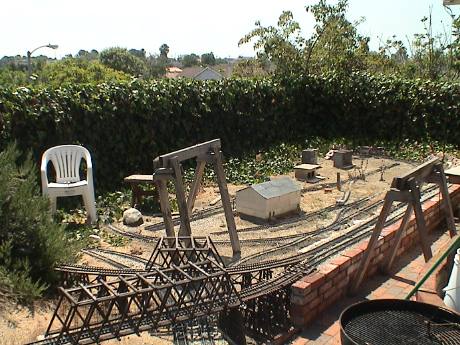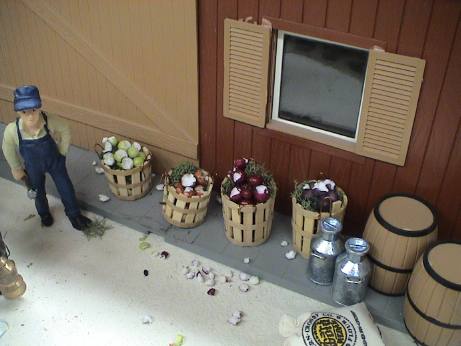I started construction of my first serious Large Scale model
railroad in the newly constructed basement of my mountain cabin in
April of 1994 although I had several simple flat layouts as test cases
starting from about 1990. In Sept 1996, I started an outdoor version in
the backyard of my home in southern California. It's now mid 2006 and
I've had more than a decade of experience discovering the ups and
downs of building both indoors and outdoors. This page is an attempt to
summarize my experiences so that others may learn from them as
well.
The bottom line is that there is no obviously best place to build a
model railroad. Most smaller scale model railroads are built indoors
simply because the small stuff cannot handle the outdoor environment.
HO and N scales are small enough so that some remote degree of realism
of scale is possible indoors. With large scale, prototypical curves are
simply not possible unless you are building over your indoor polo
field. Large Scale trains are marginally big enough to handle the
outdoor environment where some form of scale realism is almost
realizable so a choice might present itself.
For many people, there might be little choice. There may be no room
in one place or the other so that only one path is available. Others
may have a choice. Where they build will have serious impacts on what
they can build and how much work it takes to maintain the railroad.
Still others may go completely overboard and be totally unreasonable by
doing both.
Either way, large scale railroads are usually constrained by space.
Often some serious and protracted negotiations are necessary to secure
sufficient area for the right of way. Once rights are secured, the
trend to pack trackwork everywhere needs to be avoided. There needs to
be room for scenery and passage for the 1:1 scale people that will
enjoy the railroad. Minimal trackage in any given field of view is
good, this is the way that real railroads are viewed except in some
exceptional areas of big cities.
Indoor Vs. Outdoor
| Characteristic |
Indoor |
Outdoor |
| Prototype Selection |
Pro |
|
Wider selection of larger prototypes allowed by larger radius curves
|
| Con |
Reduced selection of prototypes
Tighter radius curves limit prototypes to narrow gauge, mining,
logging and streetcars
|
|
| Rail Code |
Pro |
Practical to use smaller code rail to allow better looking
trackwork
|
|
| Con |
"Standard" code 332 rail looks WAY too big, but at least it is
sturdy
|
Harsher outdoor environment argues for heavy code 332 rail, code 250
can work but is harder to maintain
|
| Available Area |
Pro |
|
Usually larger area available, allows wider curves, larger
separation between scenes, less dense trackwork
Sometimes a sloped area that is not otherwise very useful can be
used for right of way set into the slope.
|
| Con |
Usually restrained area argues for tight radius curves, tendency to
put too much trackwork too close
Easily can consume an entire room or more, but if a basement, garage
or attic is available, may not result in lost living space.
|
Area consumed by the railroad is pretty much lost to uses other than
gardening
|
| General Maintenance |
Pro |
Much lower
|
|
| Con |
|
Much higher, itemized below
|
| Track Cleaning |
Pro |
Yearly, maybe less frequently when using all metal wheels
|
None unless battery power is used where dirty track will actually
provide better traction.
|
| Con |
|
Serious impact when using track power, train length power pickups
can significantly improve reliability
Even with battery power, large grit, leaves, twigs and other debris
need to be cleaned off the track
|
| Foliage |
Pro |
Simulated foliage requires little maintenance
|
If properly selected, natural foliage can be very attractive
|
| Con |
Good looking artificial foliage is either expensive to buy or time
consuming to make in the large quantities required
|
Weeding, pruning and trimming
Irrigation and removal of dead foliage
|
| Water Features |
Pro |
Simulated water features require little maintenance
|
Natural water features are practical and can be visually
attractive
Active water features can produce pleasing sounds
|
| Con |
Real water features are impractical due to leakage and humidity
issues
|
Water features of any kind are fairly high maintenance
|
| Weather |
Pro |
No "off season" if the enclosure is adequately insulated, heated or
cooled
|
Running trains outdoors in good or acceptable weather can be very
pleasant
|
| Con |
Less time spent outdoors
|
Summer heat, winter cold, rain, wind and snow can restrict train
time
|
| Weather Damage |
Pro |
"Normal" bad weather is no problem as long as the enclosing building
holds up
|
|
| Con |
none unless the conditions are so bad that the building is
damaged
|
Weather damage is a fact of outdoor life, it will happen, sometimes
seriously
Floods, hurricanes, tornados, toppled trees, lightening can totally
destroy a railroad.
|
| Track Height |
Pro |
Usually set high so that the layout is near eye level.
Storage sometimes available under the layout
Don't have to bend as much to reach the railroad (really important
for those with bad backs)
|
Usually set at ground level but can be raised on a terrace or other structures
Trains are further from the eye allowing lower levels of detail on
rolling stock, locomotives and structures
|
| Con |
Trains can be "in your face", lack of details shows up more
|
Bending and kneeling to work on the railroad or rerail trains can be
hard on the back and knees.
With the track at ground level, you will find yourself at ground level quite a lot. As one gets older, getting up from the ground gets harder. Think about this one.
|
| Scenery Construction |
Pro |
Pretty much any kind of scenery desired can be simulated
|
Nature can do some of the work
Water features are possible and can be very attractive
|
| Con |
Good looking scenery requires some significant level of artistic
skill
Scenery construction can be very time consuming
Water features must be simulated
|
More limited selection of materials available that will withstand
the environment
|
| Security |
Pro |
Better, the whole railroad can be locked up
|
|
| Con |
|
Whatever is left outdoors is subject to vandalism
|
| Gardening |
Pro |
|
Those that like gardening and trains can have it both ways
|
| Con |
Live plants on an indoor railroad are impractical
|
Can be a chore if you don't particularly like gardening
|
| Animals |
Pro |
Fewer animals to deal with
|
|
| Con |
Mice and spiders can still be a bother
Cats can knock over trains and scenery
|
All manner of wild animals can invade, from moose to mice.
Larger and burrowing animals can do considerable damage
|
| Train Storage |
Pro |
Trains can be stored right on the layout
|
|
| Con |
|
Trains must be stored indoors or they will not survive long
Considerable time and effort to bring out and put away trains unless
a track leads to indoor storage where entire trains can be brought out
at once.
|
| Electrical Issues |
Pro |
Conventional low voltage wiring practical
110 VAC equipment can just be plugged in to an available
conventional outlet although GFI is preferred
|
|
| Con |
|
Low voltage wiring must be buried to hide it, often special wire
required
110 VAC equipment must be protected from the weather and connect to
GFI outlets
|
In almost every case, either indoor or outdoor has a decided
advantage, few characteristics share the same attributes. To make your
own decision, you will need to pick the characteristics that are most
important to you and then accept the rest.
For example, if you just have to run a Hudson followed by a long
string of heavyweights, then an indoor layout will just not do the job
(unless you've actually got that indoor polo field with an attic...).
If you want to run streetcars or model logging, then you can do either. If
you've got a truly brown thumb, then maybe staying indoors would work
better but gardeners will naturally be drawn outdoors. If you live in a
bad neighborhood or your property is not well secured then maybe
indoors would work better. In either case, you will need to do some
kind of construction work, so if you are not good with tools, then
maybe you keep your plans indoor or outdoor very simple.
The most important thing is to think long and hard about what is
likely to happen in your environment and plan around the worst of the
problems.
If I had this decision to make again, I'd be torn. Indoors is clearly better from a stability and maintainance point of view. Outdoors is clearly better for the much greater flexibility in selection of equipment point of view. The final decision would have to be based the area available.
 For a lot of reasons, I had left my trains alone
for more than two years. An outdoor railroad that is not continually
maintained will soon succumb to the forces of nature, as did mine. The
ivy has grown over and through much of the trackwork, the sun has
disintegrated a significant number of Aristo tie strips and the weather
in general has caused a short trestle in the foreground to come
unglued. My kids have destroyed the trackwork leading to the garage,
it'll have to be entirely replaced. As the GIRR is rehabilitated, I
expect that I'll find a lot more stuff that has simply fallen
apart.
For a lot of reasons, I had left my trains alone
for more than two years. An outdoor railroad that is not continually
maintained will soon succumb to the forces of nature, as did mine. The
ivy has grown over and through much of the trackwork, the sun has
disintegrated a significant number of Aristo tie strips and the weather
in general has caused a short trestle in the foreground to come
unglued. My kids have destroyed the trackwork leading to the garage,
it'll have to be entirely replaced. As the GIRR is rehabilitated, I
expect that I'll find a lot more stuff that has simply fallen
apart. In contrast, the GIRR Mountain Division is
virtually unscathed. This is the extent of degradation that I found
after two full years without a single train movement. A mouse had
chewed up all of the plastic fruit in these baskets. The track didn't
even need cleaning.
In contrast, the GIRR Mountain Division is
virtually unscathed. This is the extent of degradation that I found
after two full years without a single train movement. A mouse had
chewed up all of the plastic fruit in these baskets. The track didn't
even need cleaning.